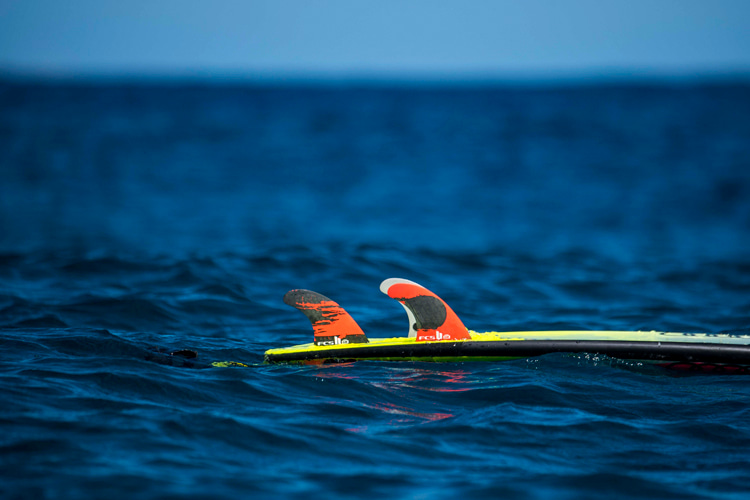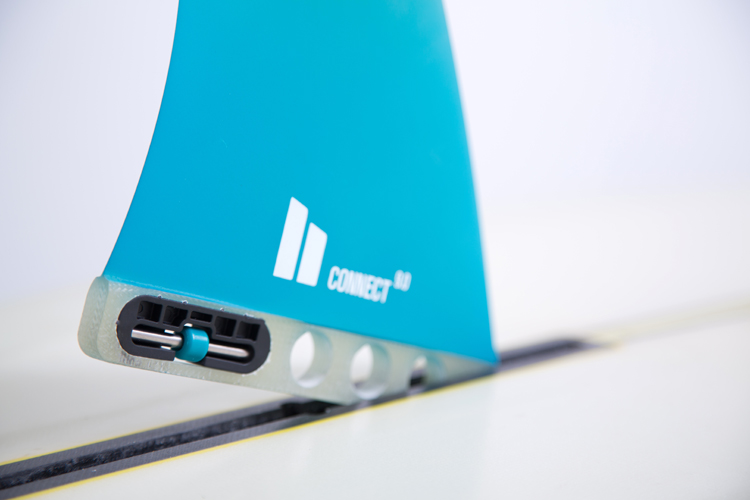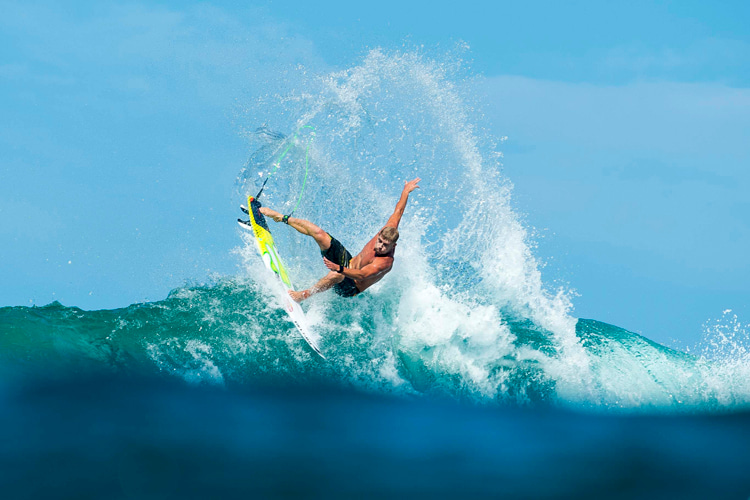Fin Control System (FCS) is a surf gear company founded in 1995.
However, FCS is also the name given to the surfboard fin system developed and patented on November 7, 1995, in Elanora, Australia, by Brian A. Whitty.
The invention enabled surfers to add versatility and different riding styles by allowing multiple fin setups to their surfboards.
With FCS, it became possible to attach and detach different types of fins to surfboards in seconds.
They can be larger or shorter in size, more or less flexible, and feature more or less pronounced designs and hydrodynamics.
In theory, thanks to the interchangeable fin system, one single surfboard can be equipped with a single fin or a five-fin setup.
Ultimately, the goal is to have a surfboard that smoothly adapts to the ocean conditions and the surfer's riding preferences.

The Making of a Global Standard
The FCS era emerged when the thruster revolution put three fins on the surfboard's tail, and they became the most popular setup worldwide.
"Initially, it was just an installation method that made the work easier for us to put the three fins," explains Whitty in the movie "Drive: Evolution of the Surfboard Fin."
"The spin-off, of course, was being able to change the fins, make your board go differently, shipping boards all over the world, and the ability not to get your fins smashed out when traveling on a plane."
"But the real reason was manufacturing and making my job easier."
In a decade, FCS quickly became the world standard for removable surfboard fins and conquered the hearts of professional shapers.
Soon, multiple signature fin templates were designed with the contribution inputs of world surfing champions.
The original FCS system features a fin with two tabs that are inserted in slots/boxes/plugs installed on the surfboard tail and secured with two screws.
The installation and removal of this fin setup takes around two minutes.
The Australian injection molded fin system dominated the surfboard market but was always challenged by its Californian counterpart, Futures Fins, and several other minor players.

Making Shaper's Job Easier
Brian A. Whitty began working as a surfboard glasser. For years, he surfed, traveled, worked, and had fun with his friend Simon Anderson.
One day, Anderson came up with the thruster idea - two side fins plus an extra one in the middle.
"It was unbelievable for surfing, but as a surfboard glasser, it was a nightmare and not much fun for the sander following me," Whitty revealed in the book "No Mean Standard," the book that celebrates the 50th anniversary of the North Narrabeen Boardriders Club (NNBC).
"I thought a slow electric drill and a hole saw would be ideal."
"After discussing it one day, someone said offhandedly, 'Maybe you should make it round.' That was it - the penny dropped."
Around 1990, Whitty used 5 and 20 cents coins as a template to design the first plugs at his North Narrabeen home.
Brian himself handsaw the original prototypes.
"I then designed the round plug system using a slot and grub screw to secure the fin with tabs."
"It was originally designed to break at the tabs, and if it was really bad, the plugs would break from the board as some sort of safety-type thing."
"In 1992, I submitted a patent application for the plugs and tab fins," explained the fin pioneer.
"The patent asked for protection of the plug and tabs on the bottom of the fins and to cover plugs and fins made of any materials."
Then, Brian A. Whitty approached Gorilla Grip with the idea of selling 6-to-9-fin surfboards.
The company owners raised their eyebrows, but after the inventor explained that surfers would buy two extra sets of fins for their boards if they could easily change them to alter the performance, the executives agreed to pay Whitty a royalty rate for an estimate of fins and plugs sold worldwide every year.
Nevertheless, the early removable system had some resistance issues, and Whitty had no funds for research and development.
"After many tries at strengthening the plugs, I was lying in bed one night and had an idea of strengthening the plugs by making a circular resin-filled post that attached to the surfboard deck," recalled Brian.
"I set about trying and testing the resin post… with the extra strength, my main hurdle was overcome; I now had confidence the plug fin system would sell and succeed."
"I cut the resin post plug out of the surfboard, then cut it in half. The cross-section of the halves resembled the letter H, so I named the strengthening the H pattern."
"This was to be the answer needed for equivalent strength provided by long-used roving glass fins."

Surfing Shifty Patent Waters
In 1994, FCS hit the market.
One year later, the patent was confirmed, and immediately after, Kelly Slater signed a deal to promote the removable fin system.
FCS was an instant hit, and according to its inventor, soon after, "it was used on 75 to 80 percent of boards made worldwide."
In the first decade, with a patent exclusivity, FCS collected between $25 and $30 for each plug system installed on a surfboard and around $50 for a set of fins sold to customers in surf shops.
Soon, FCS was using computational fluid dynamics (CFD) to analyze the forces involved in a wave ride, including lift, drag, and turning, to optimize each fin model.
In the end, it's all about increasing the efficiency of the fins and improving speed and responsiveness between maneuvers.
In 2002, Macquarie Bank saw an opportunity and bought shares of Surf Hardware International (SHI), the owner of Gorilla Grip and FCS.
After a few legal battles, FCS's patent exclusivity lost its defense shield, and more competing brands took a bit of the lion's share.
The answer arrived in September 2013, when FCS II was launched.
The no-screws, pop-in surfboard fin system made things even easier for surfers despite, initially, and according to IP Australia, it lacked an "inventive step over the prior art."
Between 2015 and 2016, the company was bought and sold at a loss by Australian online retailer SurfStitch.
FCS is constantly renewing itself, especially by introducing new manufacturing processes in the fin design production.
